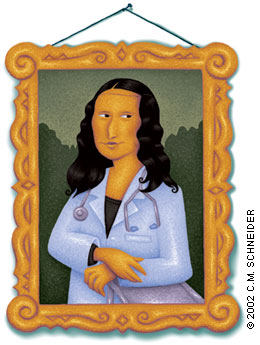
Independent practice could revive your career, but do you have what it takes to succeed?
Fam Pract Manag. 2002;9(9):41-44

It’s no secret that physician dissatisfaction is high in today’s health care environment. In fact, many physicians say they would not choose the same career path if they had it to do over again.1,2 Because of changes within the medical profession over the past several years, physicians face an increasing mountain of paperwork, more demands from regulatory agencies and third-party payers, diminished reimbursement and – perhaps most disappointing – less time to spend with patients. In response, many physicians have sold their practices and retired early or accepted salaried positions in larger organizations. But still, the satisfaction and sense of purpose that was once so inherent in our profession appears to be increasingly fleeting.
What will restore us? I believe that the very thing we are fleeing – independent practice – is what offers us the greatest hope. Based on my over 25 years of experience in solo, private practice, here are 10 reasons physicians should consider self-employed practice, and 10 ways they can empower themselves to succeed at it.
10 reasons
1. You will have 1,000 employers instead of just one. If one fires you it will be no big deal. The only real job security in today’s medical marketplace is our patients. One mismatched doctor-patient relationship still leaves you with 999 matches. But a mismatch between you and your CEO or supervisory physician could leave you looking for a job.
2. You may hang whatever pictures you like in your office without anyone saying you’re tacky. In other words, you can make your work space your own, and you won’t need a committee to approve your decor. If you’re spending more than 40 hours per week at your job, don’t you want to be comfortable?
3. Your staff will have no one else to be loyal to. People are loyal to whoever pays them. If an HMO or hospital is paying your overhead, your staff’s first allegiance will be to them. Pay your staff yourself, and they will work hard to make you happy and successful in your healing art.
4. You can come and go as you like. If you want to be a workaholic, no one will stop you. Or if you want to work just three days a week (as I do), you can do that too.
5. You won’t have to attend meetings about how to improve your efficiency and see six patients per hour. In fact, you won’t have to attend meetings period. You can decide for yourself how to balance efficiency and quality.
6. You will be the boss. You won’t have to follow policies and procedures created by someone with an MBA who knows nothing about medicine. There may be a lot we can learn from business people, but no one can understand your patients and your practice better than you.
7. You will be preserving an endangered species. No, not the bald eagle – the independent physician. Our extinction would be an unfortunate loss for the health care ecosystem.

8. You will have fun. The practice of medicine can be extremely satisfying and fun when you get to create the kind of culture you want. Besides, if you can’t have fun in a practice where things are just the way you want them, then how can you?
9. You will be rich. Learn to run your practice right, and you will be rich enough to pay back your student loans and satisfy the requirements of your imagination.
10. Isn’t this why you went to medical school in the first place? In independent practice, you are in control and can run your practice and take care of your patients the way you feel is best.
KEY POINTS
Self-employed practice is a viable and satisfying option even in today’s tumultuous health care environment.
To survive in independent practice, learn how to use your computer to post payments, schedule patients and send electronic claims.
You don’t need a fancy office or multiple staff. Investigate non-commercial sites and use one staff member per physician as your rule of thumb.
10 ways
1. Get computerized. Running an office without a computer is like using leeches for phlebotomies. Buy a practice management program that includes scheduling and electronic billing capabilities. You can be up and running with hardware and software for under $2,000. (The AAFP/Microsoft Technology Guide: Practice Management Software, www.aafp.org/x10769.xml, lists several affordable products. I use Lytec Medical, www.lytec.com. Physicians should investigate several products before deciding which one to purchase.) Don’t be confused by price. What you pay for medical management software often bears no relationship to its utility. Make sure the package you purchase comes from a company with a track record for quality, service and reliability. If you’re a resident or a practicing physician who intends to open a new practice some day, don’t wait until you’re in the new practice before you buy your system; get it now and familiarize yourself with it at your leisure.
2. Learn how to work for your office manager when he or she goes on vacation. Having a computer isn’t enough. You have to know how to use it to make appointments, create bills, post payments and send electronic claims. Unless you personally know how to run your software, you won’t be able to show your office manager how you want things done. This is your business, and for it to be successful, you need to be involved with its nuts and bolts. An aloof attitude (e.g., “I just want to practice medicine”) will leave others running your business for you, often with calamitous results.
3. Give great service. This is what keeps your patients coming back and recommending you to their friends. While all of us as physicians have been trained in giving good care, we do not always know how to give good service. Here are the fundamentals: Don’t make your patients wait. Apologize if you do. Listen attentively, and keep your hand off the doorknob while you’re with your patients. Call the next day to see how they’re doing (this alone will ensure your practice’s success) and report their test results back to finally, leave room for same-day scheduling so that you’re readily available to patients when they need you.
4. Create a niche. You will go broke if you wait for sick patients to walk through the door. There aren’t enough of them to go around. Consider doing wellness medicine, which widens the scope of potential patients to include everyone. Subspecialize in dermatology, thyroid disorders, diabetes or geriatrics. Get into occupational health – pre-employment physicals, drivers’ physicals, flight physicals, workers’ compensation for minor injuries, drug screening, etc. – and advertise that you offer these services. A river of money may run by lawyers, but it doesn’t run by physicians. We have only rivulets. But add them up, and you will have a mighty stream.
5. Offer one-stop shopping. For your patients’ convenience, do everything possible in house. Draw your own blood, check your own urines and stool guiacs, etc. You should be able to bill for these items, and your patients won’t have to wait at an outside lab to get the services they need. When your patients need outpatient procedures that you cannot offer in house, help them schedule appointments while they are in your office so they won’t have to hassle with the bureaucracy. They’re patients, which means they probably don’t feel well to begin with. Make their lives easier and they will reward you for it.
6. Hire as few employees as possible. Employees are expensive. Add 15 percent to their hourly wage to estimate their real cost, which includes payroll taxes and workers’ compensation insurance. This does not include their paid vacations (at least one week to start, but three to four weeks after many years of service), paid holidays (a minimum of six per year), sick and maternity leave and, after three years of employment, your contribution to their retirement plan. Now, we’re talking real money. Forget what all the industry benchmarks suggest and hire one employee per doctor as a rule of thumb. Have them multitask, and treat them well because they can make your professional life heaven or hell.
7. Send all claims electronically. There is no other way to process claims. Paper claims are passé, and soon, with the new Health Insurance Portability and Accountability Act (HIPAA) regulations, they will be moribund. More and more insurers are coming online, and the big players, such as Medicare, Medicaid and the Blues Brothers (Blue Cross and Blue Shield), are already there. Sending claims electronically has no downside. In addition to saving trees, it gives you real-time feedback for rejected claims and allows you to resend them. You can receive payment from some online insurers within five working days, and few take longer than two weeks. You can use the electronic claims capability of your software to do your billing for $0.45 to $0.75 per claim, depending on whether your clearinghouse can forward the claims electronically or whether it has to print and mail them. I’ve heard penny-wise, pound-foolish doctors grouse about paying $0.75 to a clearinghouse for a claim they can send for the price of a first-class stamp. Yes, you can send a paper claim for $0.37, but the real price you pay is waiting four weeks for your rejection notice or six weeks to be paid. That’s no way to run a business.
8. Be aggressive in billing. Your accounts receivable should have mostly current and “zero to 30 days” accounts. Once your accounts get out past 60 days, you’re doing something wrong. Do monthly aging reports, and follow up on all unpaid claims and bills. Call insurance companies and ask whether they’ve received the claims and what the problems might be. Sometimes they’re pending review; other times requests for additional information have been sent to the patient and have gone unanswered. Send patients their statements monthly and after their explanations of benefits arrive. Call patients with unpaid balances before turning them over to your collection agency, and let them know you are concerned about their lack of payment. Consider whether you wish to keep patients whom you have to send to collection, and if not, let them know it. Use a collection agency with a letter service. If the patient pays in response to the first notice, you owe the agency nothing; otherwise, the agency takes a percentage.

9. Pay as little rent as possible. Next to payroll, rent is your biggest expense in private practice. You don’t need a palace or even a medical office building for your practice. Consider alternative sites, such as a residential unit. The cost per square foot is less, and your patients will feel more at home. My practice is housed in a fourplex, which I own. I have converted one of the apartments into my office, and I rent out the others for a profit. Whatever you do, avoid renting from another health care provider; ultimately, you will be in another person’s space with little chance of making it your own.
10. Cultivate relationships with referral specialists, risk managers and claims reps. Referral specialists generally like giving us their advice and risk managers are paid to Claims reps, contrary to popular belief, are not instructed to be obstructionists to physicians but are usually quite helpful with inquiries. Consulting with these groups liberally will result in better patient care, decreased liability and increased reimbursements, so don’t be too proud or too busy to call in their help.
Bottom line
Perhaps the most important tip of all is don’t forget to take care of yourself as you take care of your patients. To avoid burnout, pursue your avocations passionately and deeply. You need downtime to relax and re-energize. Besides, some day you will retire and you will want to be prepared for it, so practice now having a life outside of your work.
Second, put your family first. You may not think you need them when you’re on top of the world professionally, but when you fall, you will want them to be there to catch you. Don’t neglect those relationships. Third, make medicine work for you. You have too much time, energy and money invested in your craft to drop out, retool or retire prematurely. If you don’t like working for someone else, work for yourself like family docs used to do. You can do this, and you will wonder why it took you so long. Trust me – I’m a doctor.